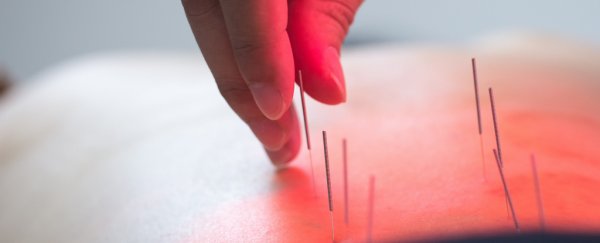An acupuncturist in New Zealand has accidentally pierced a young woman's lungs, after inserting needles in her shoulder region too deeply.
The 33-year-old patient was seeking treatment for an arm and wrist injury, which was causing pain on top of her shoulders and a shortness of breath. To treat her, the acupuncturist decided to place two needles in a nearby acupressure point, known as Jian Jing or Gallbladder 21 (GB21).
As the needles were going in, the young woman expressed pain, and later, she told the Health and Disability Commissioner that the insertions felt "extremely deep". Both needles were left in for half an hour, before they were then rotated and removed.
It was at this point that the patient felt a sudden onset of pain in her right chest and a shortness of breath. She told her acupuncturist she felt "stuffy" and she was having a strange and painful 'air' sensation around both her lungs.
The patient was sent home to rest up and take it easy, even though she was still feeling "very uncomfortable" at the end of treatment.
Later that night, the woman's husband took her to the hospital, where she was quickly referred to the emergency department. According to the New Zealand Herald, doctors here diagnosed the young woman with bilateral apical pneumothoraces, which is a lung collapse on both sides of the body, due to a top-side puncture.
In subsequent legal proceedings, it was ruled that the acupuncturist was to blame. The provider was in breach of health code, according to a commissioner, because they did not fully explain the risks to their client and they did not receive written consent.
Before the acupuncturist can practise again, they will now need to undergo further training and create an information brochure and a written consent system for their practice.
It's a tough but necessary punishment for a relatively unregulated therapy. Despite being a rare event, punctured lungs are a common and serious complication described in acupuncture. Just a few months ago, we reported on an older woman whose lung collapsed after a thin acupuncture needle was inserted into her back.
Both providers and patients need to be aware of these risks; too often, they are not. Because the symptoms of pneumothorax can often be delayed, the risk is under-recognised and under-reported by acupuncturists and their patients.
Instead, it's hospital and emergency staff who are forced to deal with potentially fatal consequences, and dangerous practices continue on their way.
The Jian Jing pressure point is a particularly risky acupressure spot for the lungs and this has been known for hundreds of years. In a study from 2010, 30 percent of pneumothorax resulting from acupuncture were caused by needling in the GB21 pressure point.
Many researchers have tried to figure out what a safe needling depth in this area is, but such estimates vary widely from person to person. There also many other points that can be dangerous to the lung as well.
An acupuncture safety review by the World Health Organisation (WHO) found that most traumatic events are caused by "improper manipulation in high-risk acupoints".
"The depth of needle insertion is crucial," the report reads.
"The lung surface is about 10 to 20 mm beneath the skin in the region of the medial scapular or midclavicular line. This may explain the high incidence of pneumothorax during needling in this area."
While some of its claims are not supported by scientific evidence, generally speaking, acupuncture is viewed as a fairly safe and non-invasive alternative medicine treatment. But take it too far, and even a seemingly benign procedure can become life-threatening.
